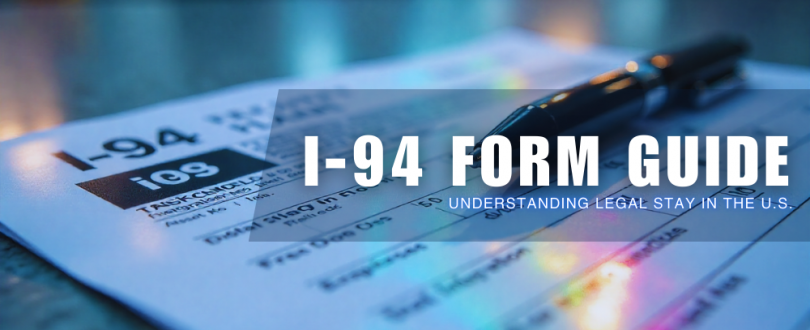
Your I-94 form may be more important than your visa stamp—here’s why.
For every foreign national entering the United States, the I-94 is the unsung hero of lawful travel. Officially known as the Arrival/Departure Record, this document is issued by the U.S. Department of Homeland Security (DHS) through U.S. Customs and Border Protection (CBP). While most travelers focus on visas as the key to their U.S. journey, the I-94 is the record that actually governs your stay, proving your legal entry and setting the timeline for how long you can remain.
What is the I-94 Form?
The Form I-94 is the government’s official record of a foreign national’s arrival and departure from the United States. Issued by U.S. Customs and Border Protection (CBP), it contains essential details such as the date you entered, the visa category you were admitted under, and the final date you are authorized to remain.
Depending on how you enter the U.S., the I-94 may come in different formats:
– Air and Sea Travelers: Since 2013, CBP has issued electronic I-94s automatically. No more paper slips stapled into passports; you can access your record online.
– Land Border Crossings: Many travelers still receive a paper I-94 at the port of entry, though pre-applying online is also an option.
No matter the form—paper or electronic—the I-94 is critical. Travelers should always check the accuracy of their records and keep a copy for future immigration or legal needs.

Main Functions of the I-94 Form
The I-94 is more than just an arrival record; it performs several critical functions for travelers and the U.S. government alike.
Proof of Legal Entry and Stay
The I-94 confirms that you were lawfully admitted into the United States. It serves as proof of your legal status during your stay.
Tracking Authorized Duration of Stay
Your “Admit Until Date” on the I-94 dictates how long you can remain in the U.S.—not the expiration date on your visa. This distinction is vital, as overstaying your I-94 makes you “out of status,” regardless of visa validity.
Immigration Benefits and Status Changes
When applying for benefits such as work authorization, a visa extension, or permanent residency, the I-94 is a required piece of evidence proving your current lawful presence.
Record of Entry and Exit
CBP uses the I-94 to track travelers’ comings and goings, ensuring compliance with U.S. immigration laws.
Access to Other Services
Beyond immigration, the I-94 often acts as proof of status for everyday needs—such as applying for a driver’s license, opening a bank account, or filing taxes.

How to Get an I-94 Form
The process of getting an I-94 is largely automatic, but it varies depending on how you enter the U.S.:
Air & Sea Travelers: Since May 2013, CBP has issued electronic I-94s automatically at ports of entry. You won’t get a paper slip, but you can retrieve your record online.
Land Border Crossings: Many travelers still receive a paper I-94 upon arrival; however, you can also pre-apply electronically for a provisional I-94 to expedite the process.
Accessing Records: Travelers can look up and print their I-94 through the official CBP website or by using the CBP One mobile app.
Pro tip: Always check your I-94 for accuracy and keep a saved or printed copy. A single clerical error can cause big problems later.
How Long is an I-94 Valid?
The validity of your stay in the United States is tied not to your visa’s expiration date, but to the “Admit Until Date” printed on your I-94. This subtle distinction often catches travelers off guard. A visa merely allows you to request entry at the border, while the I-94 determines how long you are allowed to remain.
Overstaying the date on your I-94 isn’t a small mistake; it puts you out of status. That can trigger serious consequences, including:
Visa cancellation on the spot.
Bars on re-entry for years.
Even removal proceedings in severe cases.
In other words, if your visa is the ticket, the I-94 is the clock—and when it runs out, so does your lawful stay.
Why the I-94 Form Matters Beyond Immigration
The I-94 isn’t just for immigration officers—it shows up in everyday life too. Many institutions require it as proof of legal presence, including:
-State DMVs when you apply for a driver’s license.
-Banks, which may need it to open an account.
-Employers and tax authorities use this information as part of verifying your lawful presence for work or tax filings.
In short, the I-94 doubles as your all-purpose ID for legal status in the U.S., opening doors not only to immigration benefits but also to essential services that make living in America possible.
The I-94 form can be electronic or paper-based, depending on the mode of entry (air, sea, or land) and specific circumstances. Air and sea travelers typically receive an electronic I-94 automatically created at the port of entry, whereas land border travelers may get a paper form or apply electronically before arrival.
For foreign nationals, it is important to keep a copy of the I-94 and ensure the information is accurate to avoid legal issues and to have evidence of lawful presence when required.
Key official resources for more information or to retrieve Form I-94 records online include the CBP official I-94 website and the CBP One mobile app.
Frequently Asked Questions (FAQ)
- Is the I-94 the same as a visa?
No. A visa allows you to request entry into the U.S., but the I-94 determines how long you’re legally allowed to stay once admitted. - How can I check my I-94 record?
You can look up and print your I-94 online through the official CBP I-94 portal or access it via the CBP One mobile app. - What happens if I overstay my I-94?
Overstaying makes you “out of status,” which can lead to visa cancellation, bars on re-entry, or even deportation. Always track your “Admit Until Date.” - Do all travelers get an I-94 automatically?
Yes, but the format varies: air and sea travelers receive an electronic I-94 automatically, while land travelers may still get a paper form or pre-apply electronically. - Why do I need an I-94 for non-immigration purposes?
Many U.S. institutions—like DMVs, banks, and employers—require the I-94 as proof of lawful presence when issuing a driver’s license, opening accounts, or verifying employment eligibility.

